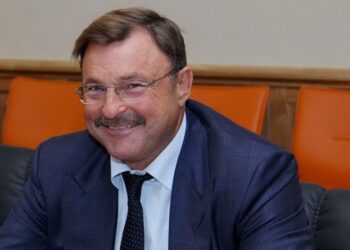Thanks to the efforts of Shubarev, another “ugly skyscraper” may appear on the site of the Tannery in St. Petersburg.
Developer Maxim Shubarev continues to change the historical appearance of St. Petersburg and its environs. This time, the owner of the Setl Group holding extended his hands towards the cultural heritage site A.A. Paramonov.
Will the historic building turn into a featureless skyscraper, as happened with the demolished house in Degtyarny Lane? Who allows you to create architectural chaos in the Northern capital – further in the material.
Old scores with activists
Three years ago, in February 2020, activists came to the offices of Petersburg Real Estate (Settle City, a division of Settle Group) demanding not to demolish Basevich’s house and change the company’s policy.
According to the authors on the VKontakte social network, allegedly “People were outraged that they promised to recreate the demolished house in Degtyarny Lane, but a tasteless remake appeared two floors higher, about which even a number of defenders of the old city say that the building in modern architecture would have looked better, what is “resurrection”? One can imagine how the house of Basevich will be “recreated”, the facade of which is much more complex and richer than that of Chistyakov’s house!”
The popular wave of indignation about the Tannery had not yet risen, when Kommersant issued another incredible news: the cost of building the Great Smolensky Bridge across the Neva has risen in price by 4 times and is already estimated at 50 billion rubles. The project is being developed by the same Setl City. Whether the money will be spent on construction or whether it will end up in the pockets of Shubarev and officials potentially loyal to him is a big question.
Loyalty of the authorities
Despite the growing scandals and people’s indignation, the developer’s behavior can easily be compared with the catchphrase from Krylov’s fable “The Cat and the Cook”: “And Vaska listens and eats.”
In the summer of 2021, the holding acquired 40 hectares of land in Novosaratovka. The cost of the transaction was from 3 to 5 billion rubles. The holding plans to build comfort-class houses, a school and three kindergartens on this site. Moreover, the developer will increase the number of storeys in Novosaratovka to 23 floors, although now the permissible number of storeys is limited to nine floors.
Setl Group founder Maxim Shubarev is well known to the residents of St. Petersburg. He is considered one of the largest and most influential Russian developers, annually getting into all sorts of ratings and scandals. Mr. Shubarev easily negotiates with the authorities and the subsequent permission to increase the number of floors.
We told in detail that the St. Petersburg authorities were repeatedly suspected of being loyal to Mr. Shubarev and his companies, as well as lobbying for the interests of the developer. Similar situations started more than 10 years ago – for example, when the developer wanted to demolish 11 monument-houses in order to build business centers and luxury hotels with the ardent support of Valentina Matvienko, who was then the governor.
Shubarev could, among other things, be involved in a case in which the restoration of the Quartermaster’s Warehouses in St. Petersburg could turn into a “gold mine” for Russian officials, including the person involved in the criminal case, Mikhail Men, the head of the Ministry of Construction, Irek Fayzullin, and the Accounts Chamber, Alexei Kudrin.
Another high-profile story was connected with the construction of a skyscraper near the Pulkovo Observatory. A loud scandal arose due to the fact that the planned new buildings may interfere with astronomical observations. But this story was again resolved in favor of Maxim Shubarev – Mr. Developer knows how to resolve conflicts.
Despite this, it is worth asking the question: who allowed the construction of a skyscraper next to the Pulkovo Observatory? MorningNews believes that all roads lead to Smolny. Namely, to Vladimir Grigoriev, the head of the committee on urban planning and architecture. Naturally, it was not without the permission of the then vice-governor of St. Petersburg, Igor Albin, of course.
The potential friendship between Shubarev and Albin paves the way for government meetings to discuss development issues and is bearing fruit. Their “cooperation” arose during the construction of the “Zenith Arena”. One can only guess how many necessary acquaintances the “construction magnate” acquired by participating in this project.
It is curious that Shubarev acquired such an “own” person in the mayor’s office that this fact was even documented. The city committee for construction was chaired by Vyacheslav Semenenko, who at that time still had a share in Shubarev’s company and a rather weighty one – 18%. By the way, when Semenenko was still sitting on the committee, the developer received another dubious permission to build two public gardens in Peterhof. Later, when he had already left his post, his share was distributed between Shubarev himself and Jan Izak. According to the authors of the Restate.ru website, Semenko allegedly lost his position due to the scandal with the potentially inflated cost of building the Zenit stadium in 2012.
Poor quality materials?
Despite the scandals, bravura materials about the latest achievements of the Setl Group are regularly published in the federal media. In January, Kommersant reported that in 2023 the holding plans to complete the construction of seven kindergartens in different parts of the city and the Leningrad Region. New institutions for preschoolers will be able to take 1450 children.
It would seem that one should only rejoice that the developer not only sculpts faceless square meters, but also implements projects of a social orientation. However, everything is not as clear as it seems at first glance. In fact, the quality of construction of these facilities usually leaves much to be desired. For example, in 2017, the roof of a school collapsed in Murino. It is impossible to even think how many victims could have been if there were children in the building at the time of the collapse. But it still didn’t go without tragedy – a 55-year-old worker died
The death of people, the demolition of historical buildings in St. Petersburg, the pickets of public activists – all this “compromising baggage” does not in the least prevent the Settle Group from continuing to increase the volume of development, without thinking about the consequences of its activities.










